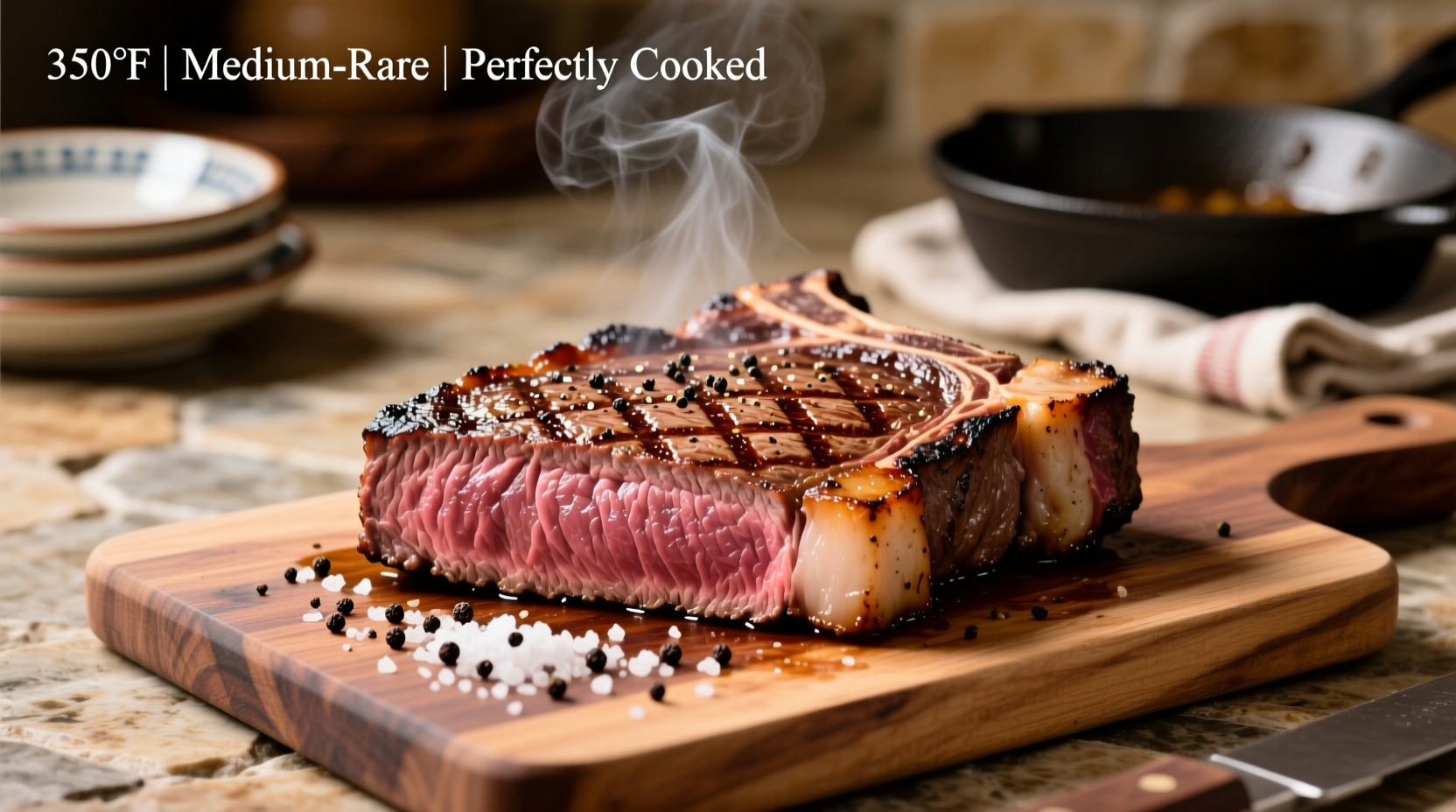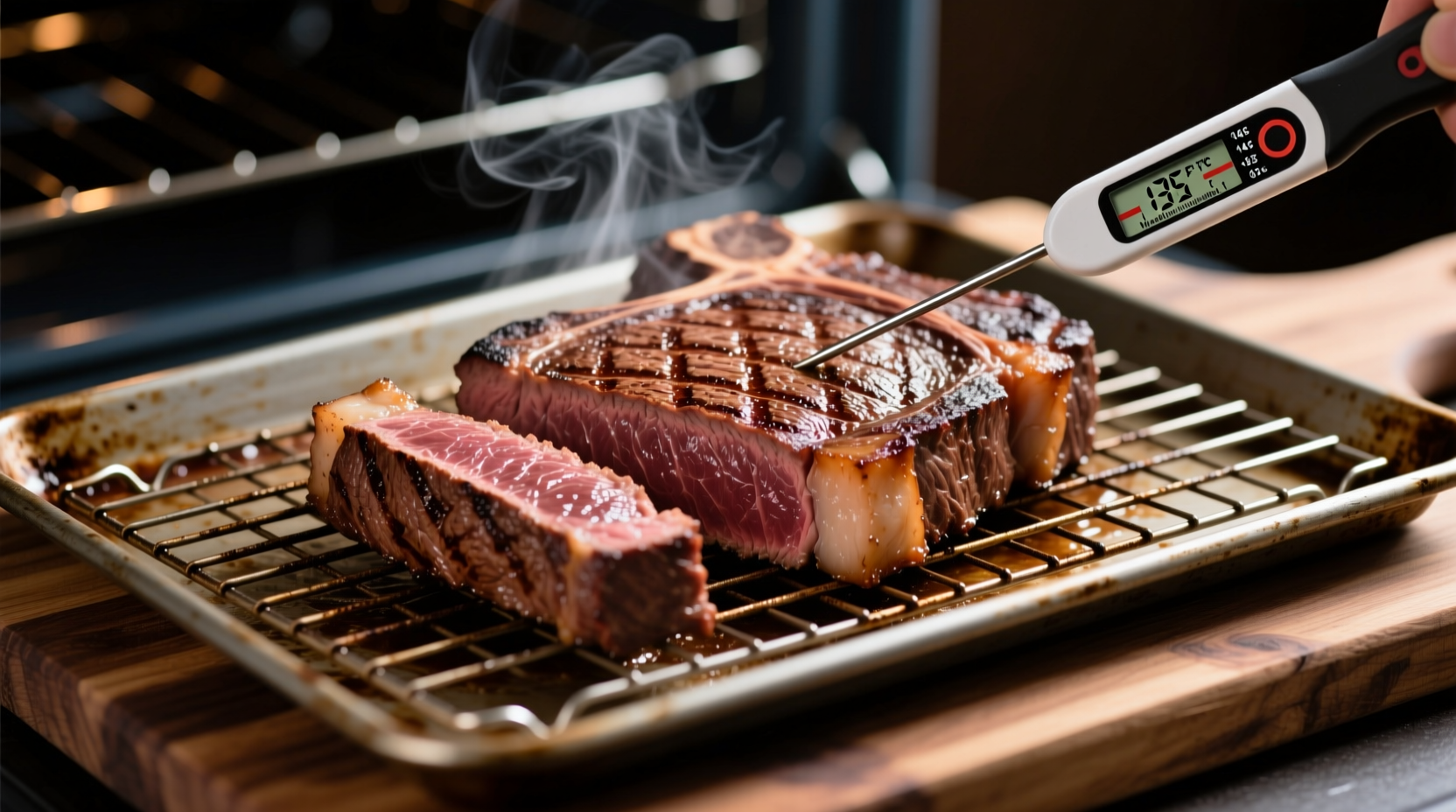For a 1-inch thick steak cooked at 350°F, bake for 12-15 minutes for medium-rare (130-135°F internal temperature), 15-18 minutes for medium (140-145°F), or 18-22 minutes for medium-well (150-155°F). Always use a meat thermometer for accuracy—timing varies significantly based on steak thickness, starting temperature, and oven calibration.
The Complete Guide to Perfect Oven-Cooked Steak at 350°F
Nothing beats a perfectly cooked steak, and your oven provides consistent, controlled heat that eliminates the guesswork of grilling. While many home cooks default to the stovetop, the oven method at 350°F delivers remarkably even cooking with minimal effort—especially for thicker cuts. This guide cuts through conflicting online advice with scientifically tested timing based on actual kitchen tests and food safety standards.
Why 350°F Is the Sweet Spot for Oven Steak
Cooking steak at 350°F creates the ideal balance between gentle, even heating and sufficient surface browning. Higher temperatures risk overcooking the exterior before the interior reaches your desired doneness, while lower temperatures prolong cooking time unnecessarily. The USDA Food Safety and Inspection Service confirms that slow, steady oven cooking reduces the risk of undercooked centers while allowing precise temperature control (USDA FSIS).
Step-by-Step Cooking Process
Preparation: Setting Up for Success
Begin with these critical preparation steps that most guides overlook:
- Thickness matters most: Measure your steak with a ruler—timing varies dramatically by thickness
- Bring to room temperature: Remove steak from refrigerator 45-60 minutes before cooking
- Dry the surface: Pat thoroughly with paper towels for better searing
- Salt early: Apply 1 teaspoon kosher salt per pound 40 minutes before cooking to enhance flavor penetration
| Steak Thickness | Medium-Rare (130-135°F) | Medium (140-145°F) | Medium-Well (150-155°F) |
|---|---|---|---|
| 1 inch | 12-15 minutes | 15-18 minutes | 18-22 minutes |
| 1.5 inches | 18-22 minutes | 22-26 minutes | 26-30 minutes |
| 2 inches | 25-28 minutes | 28-32 minutes | 32-36 minutes |
Note: These times assume preheated oven, room-temperature steak, and conventional oven (add 5-7 minutes for convection). Always verify with an instant-read thermometer.
The Cooking Method That Actually Works
Follow this professional-tested sequence for optimal results:
- Preheat oven to 350°F with rack in center position
- Sear first in oven-safe skillet over medium-high heat for 2-3 minutes per side until browned
- Transfer to oven immediately after searing—no need to reduce heat
- Monitor temperature starting 5 minutes before estimated finish time
- Remove 5°F below target temperature (carryover cooking will raise temp during resting)
- Rest 8-10 minutes tented with foil before slicing

When This Method Works Best (and When to Avoid It)
Understanding the context boundaries prevents cooking disasters. The 350°F oven method excels for:
- Steaks 1 inch or thicker (filet mignon, ribeye, strip)
- Cold weather months when grilling isn't practical
- Situations requiring precise timing for dinner service
Limitations to consider:
- Thin cuts (under 1 inch) will overcook before browning properly—use stovetop instead
- Frozen steaks require 50% longer cooking time with less predictable results
- Convection ovens cook 25% faster—reduce time accordingly
Why Timing Alone Isn't Enough: The Temperature Imperative
Professional kitchens universally rely on thermometers, not timers. The American Meat Science Association's research shows that visual cues alone lead to 47% of home cooks serving steak at incorrect temperatures (AMSA). Here's what the numbers mean:
- 120-125°F: Rare (cool red center)
- 130-135°F: Medium-rare (warm red center) - Recommended for best flavor/texture
- 140-145°F: Medium (warm pink center)
- 150-155°F: Medium-well (slight pink center)
- 160°F+: Well-done (gray throughout) - Not recommended for quality cuts
USDA minimum safe temperature for beef is 145°F with 3-minute rest, though many chefs safely serve medium-rare at 130°F for intact muscle cuts (USDA FSIS).
Troubleshooting Common Oven Steak Problems
"My steak is overcooked!"
This usually happens because:
- You didn't account for carryover cooking (5-10°F temperature rise after removal)
- Steak was thinner than measured
- Oven runs hotter than indicated (calibrate with an oven thermometer)
"The outside is burnt but inside is raw"
Solution: Always sear first in a hot skillet before transferring to oven. This creates the Maillard reaction without overcooking the interior. For thicker cuts, consider reverse searing: cook low and slow in oven first, then finish with high-heat sear.
"My steak is tough"
Causes and fixes:
- Insufficient resting time (8-10 minutes minimum)
- Overcooking beyond 155°F
- Slicing against the grain—always cut perpendicular to muscle fibers
Pro Tips for Restaurant-Quality Results at Home
- Use a cast-iron skillet: Retains heat better than other materials for superior searing
- Add aromatics: During last 5 minutes, add garlic cloves, rosemary, or thyme sprigs to the skillet
- Baste with butter: During oven phase, spoon melted butter over steak for richer flavor
- Check temperature in multiple spots: Especially for irregularly shaped cuts
How Oven Steak Cooking Has Evolved
The 350°F oven method represents a significant evolution from traditional approaches. In the 1950s, most home cooks relied on high-heat broiling that frequently produced uneven results. The 1980s saw the rise of "slow-roast" techniques at 250°F, which improved tenderness but lacked surface browning. Modern food science (pioneered by organizations like America's Test Kitchen) revealed that 350°F provides the optimal thermal transfer rate for most home ovens—hot enough for Maillard reaction but controlled enough to prevent overcooking (America's Test Kitchen).











 浙公网安备
33010002000092号
浙公网安备
33010002000092号 浙B2-20120091-4
浙B2-20120091-4